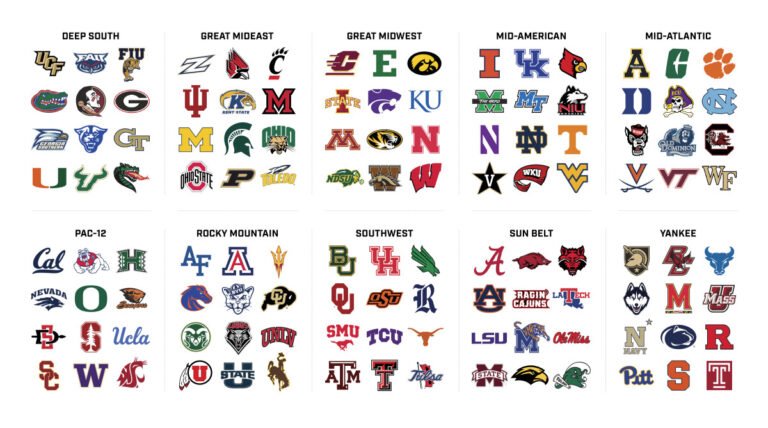As we approach the year 2025, the landscape of college sports is on the brink of a significant transformation with the highly anticipated conference realignment 2025. This strategic reshuffling of athletic conferences is poised to redefine the competitive dynamics and reshape the collegiate sports industry as we know it. Fans, athletes, coaches, and stakeholders alike are eagerly awaiting to see how this game-changing realignment will unfold, paving the way for new rivalries, enhanced competition, and fresh opportunities for teams across the nation. In this blog series, we delve deep into the intricacies of conference realignment 2025, exploring its implications, potential outcomes, and the future trajectory of college sports in this exciting era of change.
Introduction to Conference Realignment in College Sports
Conference realignment is a strategic reorganization of college sports conferences aimed at enhancing competitiveness and financial opportunities for universities. In 2025, the landscape of college sports is undergoing significant changes, with conferences reshuffling to optimize revenue and competitiveness.
Impacts of Conference Realignment
Realignment boosts conference revenues through new television deals and increased exposure, fostering growth and sustainability in the ever-evolving sports ecosystem.
Enhanced Rivalries
Conference realignment reignites traditional rivalries and creates new matchups, intensifying the excitement and fan engagement across various sports.
- Increased competition levels
- Expanded fan base

History of Conference Realignment
Conference realignment has been a prominent feature in the landscape of college sports for years. The concept of realigning conferences gained traction in the early 2000s as universities sought to maximize revenues and enhance their competitive positions.
Major Realignment Waves
One of the major realignment waves occurred in 2010-2014 when several powerhouse programs switched conferences, leading to significant changes in college sports dynamics. This period saw the formation of new conference alliances and the dissolution of traditional rivalries.
Another significant realignment phase took place in 2020, as universities sought to adapt to the evolving landscape of collegiate athletics. Conference realignment in 2020 set the stage for the future changes that would unfold in the coming years.
Impact on College Sports
The effects of conference realignment reverberated across college sports, influencing everything from TV deals to recruiting strategies. Realigned conferences aimed to create more competitive matchups and enhance their national exposure, targeting long-term sustainability.
- Enhanced Competition: Conference realignment often led to new rivalries and competitive matchups, energizing fans and players alike.
- Financial Implications: Realignment decisions were driven by financial considerations, with universities seeking to secure lucrative broadcast deals and increase their revenue streams.
Current Landscape of College Sports Conferences
As we approach the anticipated year of 2025, the realm of college sports conferences is abuzz with talks of conference realignment. Various institutions are strategically positioning themselves to make significant moves that could reshape the future of college athletics.
Power Shifts and Alliances
In the quest for greater visibility and financial gains, conferences are exploring new partnerships and alignments. The power dynamics within conferences are constantly evolving, leading to interesting shifts in the college sports landscape. Conference realignment plans are being carefully crafted to ensure long-term sustainability.
Impact on Traditional Rivalries
The restructuring of conferences may have profound effects on traditional rivalries that fans have cherished for decades. As teams realign and form new alliances, the age-old matchups that defined college sports may undergo significant changes, ushering in a new era of competition and camaraderie.

Factors Driving Conference Realignment in 2025
Conference realignment in 2025 is being primarily driven by several key factors shaping the landscape of college sports. These factors are instrumental in reshaping the competition, revenue models, and overall dynamics of collegiate athletics.
1. Competitive Balance and Strength
The pursuit of competitive balance and enhancing the strength of conferences is a major driver behind realignment efforts. Universities seek to align with institutions that can elevate their competitive standing and offer exciting matchups for fans. Some schools are making bold moves to join or form super conferences to enhance their competitiveness.
2. Financial Considerations
Financial considerations play a crucial role in conference realignment decisions. Institutions are looking to increase revenue streams through lucrative television contracts, sponsorships, and enhanced ticket sales. Creating more attractive conferences with high-profile matchups can lead to increased financial gains for participating schools.
3. Geographical Alignment
Geographical alignment is another factor influencing conference realignment in 2025. Schools are seeking to reduce travel costs and create regional rivalries that can boost fan engagement and attendance. Aligning conferences based on geographic proximity also promotes sustainability and reduces the carbon footprint of collegiate sports travel.
Predictions and Speculations for Conference Realignment in 2025
As we look ahead to 2025, the landscape of college sports conference realignment is poised for significant shifts. With evolving priorities, financial considerations, and competitive dynamics, several predictions and speculations are emerging:
Increased Power Five Consolidation
It is anticipated that the Power Five conferences will strengthen their positions by potentially expanding or reorganizing. Schools may switch allegiances to align with more lucrative opportunities, reshaping the hierarchy of college sports.
This consolidation could lead to increased financial disparities and amplify the competitive divide within college athletics.
New Alliances and Emerging Conferences
Amidst the realignment frenzy, we could witness the formation of new alliances and conferences as schools seek to optimize their positions. These emerging conferences may provide unique sponsorship opportunities and enhance exposure for participating teams.
- Collaborations between traditional rivals
- Geographically strategic partnerships
- Specialized conferences focusing on niche sports
Impact of Conference Realignment on College Sports
Conference realignment in 2025 is set to revolutionize the landscape of college sports, bringing forth significant changes and challenges for universities and athletic programs across the country. One of the primary impacts of conference realignment is the reshuffling of teams and conferences, leading to new rivalries and matchups.
Financial Implications
The financial implications of conference realignment can be profound, with universities looking to secure lucrative media rights deals and increase their revenue streams. This can lead to disparities in funding among conferences, affecting the competitive balance in college sports.
This shift in finances can also influence facilities upgrades, coaching salaries, and overall program investments. Universities may need to adapt their budget allocations to remain competitive in their newly realigned conferences.
Recruitment and Fan Engagement
Conference realignment can have a significant impact on recruiting efforts for college teams. With changes in conferences, student-athletes may be drawn to schools in more prestigious or competitive conferences, affecting the talent pool of teams. Coaches and recruiters must adapt their strategies to attract top prospects amidst these changes.
In addition, fan engagement may fluctuate as traditional rivalries are altered or new ones form. Schools must find innovative ways to maintain fan loyalty and interest, leveraging social media and marketing initiatives to connect with supporters.
Frequently Asked Questions
- What is conference realignment in college sports?
- Conference realignment in college sports refers to the shifting of schools from one athletic conference to another. This usually occurs to enhance competitiveness, increase revenue, or strengthen regional ties.
- Why is conference realignment important in college sports?
- Conference realignment is important in college sports as it can impact the competitive landscape, scheduling, rivalries, and financial stability of athletic programs. It can also influence television contracts and exposure for the participating schools.
- How does conference realignment affect college athletes?
- Conference realignment can impact college athletes by changing the level of competition they face, the exposure they receive, and the travel requirements for games. It can also influence their chances of playing in high-profile matchups and championships.
- What factors drive conference realignment decisions?
- Conference realignment decisions are usually driven by financial considerations, such as TV contracts and potential revenue growth, as well as competitive factors like enhancing the strength of a conference or securing lucrative postseason opportunities.
- Are there any risks associated with conference realignment?
- Yes, risks associated with conference realignment include potential instability for conferences and schools, negative impacts on traditional rivalries, and the possibility of alienating fans and alumni. It can also lead to legal disputes and financial challenges.
Unveiling the Future: Conference Realignment 2025
As we delve into the realm of conference realignment 2025, it becomes evident that the landscape of college sports is on the brink of a significant transformation. The revelations and speculations surrounding the realignment have sparked excitement and intrigue among fans and stakeholders alike.
Teams and conferences are gearing up for potential changes that could reshape the competitive dynamics and geographical alignments. While uncertainties loom, one thing is certain – the future of college sports is poised for a thrilling evolution.
In summary, conference realignment 2025 stands as a pivotal moment that holds the promise of new rivalries, enhanced competitiveness, and expanded opportunities. The journey ahead is bound to be riveting, and fans can brace themselves for an exhilarating ride into the future of college sports.


